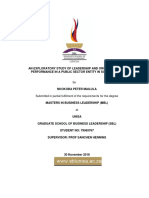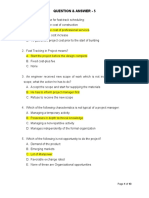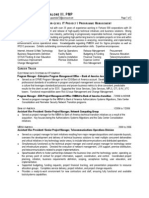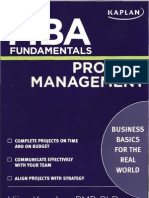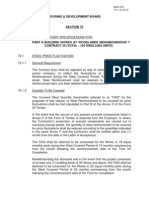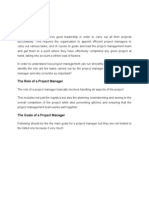CH 02
CH 02
Uploaded by
Ahmet AvcıCopyright:
Available Formats
CH 02
CH 02
Uploaded by
Ahmet AvcıOriginal Title
Copyright
Available Formats
Share this document
Did you find this document useful?
Is this content inappropriate?
Copyright:
Available Formats
CH 02
CH 02
Uploaded by
Ahmet AvcıCopyright:
Available Formats
2/The Manager, the Organization, and the Team
Chapter 2 The Manager, the Organization, and the Team
This chapter overviews the roles of the project manager and contrasts these roles with those of the traditional manager. The chapter emphasizes the need to adopt the systems approach to managing decisions and discusses the problem of suboptimization. The chapter also overviews the PMs responsibilities to the project as well as important criteria to consider in selecting a project manager, and project management as a profession. In terms of fitting projects into the parent organization, the chapter discusses pure project organizations, functional project organizations, and matrix project organizations. Finally, the chapter concludes with a discussion of the project team including the characteristics of effective team members and sources of intrateam conflict.
Cases and Readings
Some cases appropriate to the subject of this chapter are: Harvard: 9-687-001 Plus Development Corp. (A) This 17-page case highlights the difficulty of managing a fast-paced, high technology development project that includes international elements and intense competitors. The project manager must lead an American-Japanese development project where the procedures and cultures of each side are in dramatic conflict. Harvard: 9-483-098 Mat MacGregor (A) In this case, a marketing-engineering project is in trouble with many conflicts and a new project manager must be found. Harvard: 9-192-151 Concordia Casting Co. This 12-page case describes the change in leadership of a major information systems conversion project that is found to be a year behind schedule. Involves issues of organizational change, conflict, management style, and human resource policies Harvard: 9-195-141 Oticon A/S: Project 330 This 17-page case describes the reorganization of a Danish hearing aid manufacturer around projects, knowledge, and personal development. Details the implementation process and threats from early losses. Harvard: 9-689-035 Honeywell Residential Control Division: New Product Development This long (38-page) case illustrates the organization of three different product development projects in the Residential Controls Division. Considerable information on the different approaches to product development depending on the market and environment. Also discusses the issue of evolutionary change versus cold-turkey change in organizations and procedures.
15
2/The Manager, the Organization, and the Team
Harvard: 9-390-012 Fan Pier This 19-page case concerns an entrepreneurial start-up involving fraud and how to resolve the problem. Includes conflicts with bureaucracy and public relations problems Harvard: 9-181-018 Pathfinder Engineering and Construction Co. This case concerns a new project manager in a bid estimating group beset with multiple conflicts. Some readings appropriate to the subject of this chapter are: H.K. Bowen, et al. Make Projects the School for Leaders (Harvard Business Review, Sept.-Oct. 1994, pp. 131-140). Relates the role of leadership to outstanding product development projects. Many examples of where leadership made a difficult project successful. Stress is on top managements support for the project managers role more than on the characteristics or actions of the project manager. R.J. DeFillippi and M.B. Arthur. Paradox in Project-Based Enterprise: The Case of Film Making (California Management Review, Winter 1998, p. 125139). This paper addresses a fascinating paradoxin this age of core competencies and knowledge-based management, how can temporary projects consisting of floating pools of workers who make a film and then disband, possibly be successful. The paper questions many of the truisms we believe in as regards organization and management. M.A. Cusumano. How Microsoft Makes Large Teams Work Like Small Teams (Sloan Management Review, Fall 1997, p. 9-20). Describes Microsofts approach to software development. This approach keeps the team creativity and autonomy typical of small groups through synchronizing and stabilizing continuous design changes. B.Z. Pozner. What it Takes to be a Good Project Manager (Project Management Journal, March 1987). This article integrates two views about the requirements for good project managers. One view concerns the personal and managerial characteristics of PMs and their ability to lead a team, regardless of the project. The other view considers the critical problems in specific projects and the PMs talents relative to these problems. A survey is first described and then the critical problems of specific projects are identified from the survey responses. Next, the skills required of project managers, as indicated by the survey respondents, are detailed. Last, the details are related back to the critical project for problems for an integrated view of the requirements for a successful project manager.
16
2/The Manager, the Organization, and the Team
J.R. Adams and L.L. Adams. The Virtual Project: Managing Tomorrows Team Today (PM Network, January 1997). This article addresses a new phenomenon in the increasingly global competitive environment geographically dispersed project teams. The competitiveness of global firms is often facilitated by new electronic technologies and these technologies are also useful to the success of globally dispersed project teams. Other aspects of such dispersed teams are more problematic, however, and this article illustrates these, as well as approaches used by project managers for circumventing them. Finally, some of the advice given in the article should be useful as well for project teams that are not geographically dispersed. R.J. Burke. Methods of Resolving Interpersonal Conflict (Personnel Administration, July-August 1969). This classic article describes a number of methods for negotiating and handling conflicts. Effective and ineffective methods are identified ranging from withdrawal to forcing. Each method is illustrated with a number of examples. Finally, the most effective method, Confrontation-Problem Solving, is described in terms of its many characteristics.
Answers to Review Questions
1. Projects are systems composed of tasks (subsystems) and also are part of larger systems (e.g., programs and organizations). As is the case for all systems, effective management requires an understanding how the parts of the system are interrelated. Not recognizing these interdependencies can lead to suboptimization of the overall system as each subsystem is managed and optimized independently. 2. Team players rather than individuals. Oriented to communication among peers, both speaking and listening. Comfortable in a social group, extroverted, good followers. Flexible, can roll with the punches. 3. Projectitis occurs when project team members form strong attachments to the project and the project begins to take on a life of its own. In such situations, the team members may actually become more loyal to the project and other team members than to the sponsoring organization. This may lead to stalling by team members as the project end nears. Some key implications of projectitis include increased costs due to the delayed project completion, perhaps the delay of other projects that depend on the afflicted project, and perhaps the subordination of overall organizational goals to the goals of the project. 4. Advantages of a matrix organization include its flexibility, access to all of the organizations technologies, functional departments able to optimize their contributions to any project, the ability to share expertise with several projects during a limited time period, a strong focus on the project, close contact with functional groups mitigates projectitis, and the ability to balance time, cost and performance across several projects. Disadvantages of the matrix organization include project team members having to report to two bosses, the difficulty in carefully managing the full set of projects, possible infighting between project managers as they battle for
17
2/The Manager, the Organization, and the Team
key resources, and perhaps more intrateam conflict. Additional advantages of the matrix form would be the potential to use the matrix structure as a stepping stone or intermediate step to a permanent process-centered organizational structure and also to preserve an organizations ability to develop competencies in particular areas. 5. Micromanagement occurs when a supervisor too closely supervises and over controls the activities of his or her direct reports. One problem with micromanagement is that it gives people the impression that they are not to be trusted or are not capable of performing the work. Another problem is that it eliminates opportunities to develop the workforce through delegation. Finally, it takes away from time the micromanager has to do his or her own job. 6. Marketing would be in better touch with the customer than other functions and thus know their needs. Marketing would be a good liaison between R&D and manufacturing. Marketing would best know the opportunity window for product launch. Marketing would be in the best position to deliver sales of the new product to appropriate customers. Marketing will have the depth of skills needed on a new product development project. The drawbacks of pure, cross-functional projects (such as projectitis) will be avoided. 7. This discussion has been moved to Chapter 7, but unfortunately, we forgot to move the review question as well. 8. The project-manager scientists had no information about budgets and schedules, and no responsibility for any aspect of their projects except scientific results. Therefore, they had no incentive to manage either schedules or budgets but did have a strong incentive to extend their projects in any way they thought might yield better or more extensive scientific results. The project office had no authority to control any aspect of project design or scope and, therefore, had no way of exerting any control over budget or schedule. 9. Primarily because they are discipline oriented and the only person from their discipline or team on the project. Thus, they find no one else to talk to and work with. It means not coordinating your efforts with others on the team to complete the project. Any project requires some independent work but it must be coordinated with the team efforts in both performance and time.
Suggested Answers to Discussion Questions
10. Most likely something else is driving it. For example, in many if not all industries, the marketplace continues to get increasingly competitive as markets become increasingly global and the pace of technological advancements accelerates. In this
18
2/The Manager, the Organization, and the Team
environment, managers are beginning to realize that techniques that worked well in the past are not as effective in these more dynamic environments. As this question alludes to, one area where this is particularly evident is the shift in style of management. Much of this shift is related to the trend toward flatter organizations, a recognition of the critical flaws associated with the traditional functional organizational structure, and the need for flexibility in more dynamic environments. External factors such as increased mobility of labor make it necessary to use a managerial style that is consistent with high labor retentionparticipative management for example. 11. Other dangers include micromanagement by the client and delays in completing the project due to the continuous interruptions. One way scope creep can be monitored is by tracking the number of change orders to the project and summarizing these change orders by the source of the request for the change. 12. Any problem that will likely impact the projects completion date, budget, or performance should be reported to management. Problems that can be resolved internally by the project manager and project team that will not impact the projects completion date, budget or performance need not be reported formally. 13. When negotiating with functional managers for competent staff, it is important to look at it from the functional managers point of view and point out how releasing key personnel will benefit the functional manager and his or her department. Such benefits may include increased visibility with senior management, professional development of the employees, and perhaps more work for the department if the project succeeds. It may also be worthwhile to communicate to the functional manager the importance of the project to the overall organization and the relationship between the overall organizations health and the functional managers department. 14. Project managers that do not appropriately trade-off process and progress often end up with burnt out teams. We are all familiar with the fable of the man who killed the golden goose.
15.
This simply means that projects involving high levels of technological uncertainty and are also complex require a project manager that is open to new ideas and experimentation, but who also provide a relatively structured environment that is important in keeping uncertain, complex projects on track.
16. In the early 1990s proponents of reengineering argued that functional organizational structures be abandoned in favor of organizing work on the basis of specific valuecreating processes. From this process perspective, it becomes clear that most projects are actually processes that are executed on an ad-hoc basis. The reason for treating routine processes as projects is that it facilitates the formation of cross-disciplinary teams and is often easier than implementing a true process-centered organization. Thus, one way routine processes can be treated as projects is through the formation of cross-disciplinary teams.
19
2/The Manager, the Organization, and the Team
Another explanation is that top management liked the results of project management in terms of schedule and budget. Thus, they started applying it to normal activities by creating artificial deadlines and budgets. 17. Mixed organizational systems would have all the problems of the organizational systems used in addition to the problems of managing and coordinating a diverse set of organizational systems. 18. It might be wise to defer conflict when emotions are high and a cooling-off period would allow a more rationale discussion of the issues.
19.
Planning a wedding is a typical example given by students. Project management is particularly appropriate for planning a wedding because weddings involve a large number of interrelated activities, there is a clear due date, and typically a clear budget.
Incidents for Discussion Suggested Answers
Frankson Inc.: Baresak is correct in her assumptions. The functional managers are probably rewarded on the basis of their departmental performance rather than their contribution to the firm as a whole and hence have little incentive to work together. Baresak should point out to Frankson that strong functional managers cannot be strong interdisciplinary managers also, and that a special manager in charge of such team efforts should be appointed, at least on a trial or pilot basis. The existing incentive system should also be changed to provide support to the new project manager, as well as to provide incentive for working together. Toledo Medical Center: The strong technical background is not an important consideration as a project manager; the ability to coordinate others work is far more important. Meticulous attention to detail is actually a drawback for a project manager because it leads to micromanagement. A PM must rely on work of others. Being available is useful, but is not a critical advantage. The best PM is the one who can get the job done. Experience on building construction would be a plus, but not as important as the above points. The additional information needed is to identify the project management skills and experience of the potential project manager.
Suggested Case Analyses and Solutions
Quantum Bank Teaching Purpose: This case provides students with the opportunity to apply the selection criteria discussed in the chapter for a project manager to oversee a website expansion project. Given the technical nature of this project, a key point of discussion is related to the issue of how much technical expertise the project manager needs to effectively manage this project.
20
2/The Manager, the Organization, and the Team
1. Who would you recommend Stacey select to serve as project manager? Why? Andy Dover. The only dimension that Bill Fence would seem to dominate on is the technical expertise. However, from the case, it appears that Andy has sufficient expertise to manage the project. Given the backgrounds of the two candidates, it is likely that Bill would focus more on technical issues while Andys focus would likely be on the bigger picture, particularly given his MBA and the fact that he spent a year rotating through various departments at the bank. Of course, Bills tenure at the help desk likely exposed him to a variety of departments, but at a different level. In terms of the criteria listed in the book, Bill would obviously have strong technical credibility, while Andy would likely have adequate technical credibility. Furthermore, the description of Bills desk and the fact that Andy was always seen carrying his planner suggests that Andy would likely have more administrative credibility. Also, the description of Andy suggested the requisite sensitivity required of a PM. Finally, Andys experience with large process improvement projects, his natural tendency toward viewing things as systems, and his solid communication skills would serve him well as the PM of this project. 2. How would you recommend this project be organized? Functional project? Pure project? Matrix? Why? Matrix. Because this project would require input beyond the IS department, organizing it as a functional project would not be appropriate. On the other hand, most of the work associated with this project falls into the hands of the IS department, and there would probably not be sufficient work to keep members from other functional areas busy over the entire project. Therefore, a matrix structure would be most appropriate where members from other functional departments could contribute to this project on an as needed and part-time basis. 3. Do you agree with Staceys decision that the project should be staffed internally? What are the major advantages of staffing the project with Quantum employees? Are there any advantages to utilizing the services of an outside consulting firm? Given the likely strategic significance of the banks online presence, staffing the project internally makes sense. If the project was staffed externally, Quantums competitors could develop similar capabilities simply by hiring the same consulting firm. Thus, the major advantage to staffing the project with internal employees is that all the learning associated with the project stays with Quantum. Of course there are advantages to utilizing the services of outside consultants including perhaps their greater expertise, larger staffs, different perspectives, and so on.
Test Questions
True/False and Multiple Choice F 1. ___ It is common practice to select the project manager prior to the project being selected. T 2. ___ The functional manager has expertise in the function he or she manages, but the
21
2/The Manager, the Organization, and the Team
project manager rarely has expertise in many of the projects technical areas. F 3. ___ It is critical to the projects success that the project manager has expertise in the projects technical components. F 4. ___ A successful project manager is one who can avoid conflict between functional departments and the project team. F 5. ___ The project manager is supposed to facilitate the work of the project team and must, therefore, stay aloof from the conflicts arising among project team members. F 6. ___ Because the project manager is dependent on the functional managers for the human resources required to carry out the project, the project manager must avoid conflict with the functional managers. T 7. ___ A good project manager adopts a systems approach to managing problems. F 8. ___The project manager should take a careful, analytic approach to making decisions about projects. T 9. ___ Suboptimization is defined as optimizing the subsystems of a larger overall system. F 10. ___ If the performance of all subsystems is optimized, it follows that the overall system is optimum. T 11. ___ The project manager must maintain a high level of flexibility in dealing with people. F 12. ___ A project is more likely to be successful if team members stay focused on their individual functional disciplines. T 13. ___ It is appropriate for the project manager to play an active role in communications between the client and the senior management of the organization conducting the project. F 14. ___ The project manager is responsible for communicating with the project team and with senior management, but senior management maintains sole responsibility for communicating with the client. T 15. ___ The individual with responsibility for performing a task is more likely to overestimate the time required to complete the task than his/her immediate supervisor. T 16. ___ In general, senior mangers underestimate the time and resources required to
22
2/The Manager, the Organization, and the Team
accomplish tasks. T 17. ___ The project manager should not allow functional managers to usurp his or her control of the project. T 18. ___When it comes to assigning individuals to work on projects, functional managers and project managers are often in conflict. T 19. ___ It is critical to a projects success to have top management support. F 20. ___ Conflict occurs mainly at the beginning of the project. F 21. ___ A successful project manager must be able to avoid conflict. T 22. ___ A matrix organization is a combination of pure project organization and functional organization. T 23. ___ A pure project organization is usually too expensive for the management of small projects. F 24. ___ An advantage of pure project organization is its great depth of technical knowledge. F 25. ___ Cross divisional project communication is enhanced when a project is organized in a functional project organization. F 26. ___ Functional project organizations have higher personnel costs than pure project organizations. T 27. ___ Functionally organized projects are not seen as a high priority by functional managers. T 28. ___ It is common to have more than one boss in a matrix organization. F 29. ___ Matrix organizations have more limited access to the parent companys technology than functional organizations. T 30. ___ Project team members are often faced with conflicting orders in a matrix organization. F 31. ___ Intrateam conflicts are minimal in a matrix organization. T 32. ___ High self-esteem is an important characteristic of successful project team members. T 33. ___ Political savvy is not only an important characteristic of a project manager but is also important for project team members.
23
2/The Manager, the Organization, and the Team
F 34. ___ It is more important for project team members to focus on their specific project activities than on the projects overall results. T 35. ___ Morale of the project team is a key responsibility of the project manager. F 36. ___ Project team conflict stifles team creativity. F 37. ___ Project war rooms discourage team cooperation, morale and communications. F 38. ___ In addition to managing the project, the project manager must also select the projects organizational form. T 39. ___Under a pure project organization, project team members have one boss, the project manager. T 40. ___ Matrix, pure project, and functional project organizations may exist in the same company. F 41. ___ A pure project organization is characterized by many part-time project team members. T 42. ___ Near the end of the project, the project manager may have to force and beg project team members to continue working on the project. F 43. ___ When making trade-offs on a project, the project manager needs to be aware that profit for the firm is always the most important of the projects goals. T 44. ___ In general, performance is the most important of the goals for any project. e 45. ___ The project manager is responsible to: a. The parent organization b. The project team c. The projects client d. The project managers immediate supervisor e. All of the above d 46. ___ Which of the following is NOT true concerning the difference between the project manager (PM) and the functional manager (FM)? a. The PM is a facilitator the FM is a technical supervisor b. The PM is a generalist the FM is a specialist c. The PM must be able to integrate tasks, the FM must be able to analyze tasks. d. The PM uses an analytical approach the FM uses a systems approach e. All of the above are true
24
2/The Manager, the Organization, and the Team
d 47. ___ The key criterion for selecting a good project manager is: a. A strong technical background b. A good manager of people c. A good communicator with top management and clients d. A closer, gets the job done e. Pays attention to detail a 48. ___ Projectitis is most likely to occur in which type of project organizational structure? a. A pure project organization b. A matrix organization c. A functional organization d. B and C e. All of the above b 49. ___ A functional project structure is NOT characterized by: a. Lower personnel costs b. Improved communications c. Lack of projectitis d. Lack of technical knowledge depth e. All are characteristics of a functional project structure. e 50. ___ The project team members should be: a. Politically sensitive b. Technically competent c. Goal oriented d. Problem oriented e. All of the above e 51. ___ How many different types of project organizations are there? a. 3 b. 6 c. 4 d. 5 e. Unlimited number c 52. ___ The three primary goals of any project are: a. Profit, schedule, quality b. Schedule, budget, quality c. Performance, budget, schedule d. Performance, quality, schedule e. Budget, quality, profit
25
2/The Manager, the Organization, and the Team
Short Answer 53. Describe the difference between the analytic approach and the systems approach to solving problems on a project. An analytical approach to problem solving involves studying the bits and parts of the problem. A systems approach involves studying the parts of the problem and also how they fit together and interact. 54. Why are negotiation skills an important criterion of a successful project manager? Negotiation skills are requirement for good leadership. A good project manager must be able to negotiate for quality resources to be assigned to the project. He or she must be able to remove barriers to the projects successful completion, resolve conflict, persuade people, and work effectively with all of the projects stakeholders. 55. Define projectitis. The tendency of project team members, especially in a pure project organization to drag their feet as the project comes to an end. The team is concerned about their next assignment since they are not part of the functional organization. Projectitis is the tendency to delay the completion of the project. 56. Dealing with conflict is an inherent part of the process of managing projects. Explain how the project manager is supposed to deal with conflict with the functional managers whose cooperation is required to get the human resources needed to do the work of the project. (p. 27) 57. It is said that the distinction between the traditional manager-as-supervisor and the modern manager-as-facilitator is diminishing in recent years. Why? (p. 27) 58. What is meant by the phrase scope creep? (p. 30) 59. What is a virtual project? (p. 30) 60. Briefly describe what is meant by the phrase project champion? (p.30) 61. Briefly describe the project managers role as a firefighter. What sorts of obstacles do project managers have to overcome? (p. 32-33)
26
You might also like
- Solution Manual Project Management in Practice 4th Edition MantelDocument14 pagesSolution Manual Project Management in Practice 4th Edition MantelHadi HammoudNo ratings yet
- Project Management Case: From Experience: Linking Projects To Strategy of HPDocument3 pagesProject Management Case: From Experience: Linking Projects To Strategy of HPfarhanamjadpk67% (3)
- Construction Project ManagementDocument51 pagesConstruction Project Managementocduran4200486% (57)
- Project Manager RESUMEDocument2 pagesProject Manager RESUMEHeru Pramudya100% (2)
- PMAN635 Course OverviewDocument10 pagesPMAN635 Course OverviewDerrick Antonio GardnerNo ratings yet
- Project Management in Practice 4th Edition Mantel Solution ManualDocument15 pagesProject Management in Practice 4th Edition Mantel Solution ManualHouessou Houeto Hervé0% (1)
- Murdoch University Bsc203 Introduction To Ict Research Methods Project Management PortfolioDocument11 pagesMurdoch University Bsc203 Introduction To Ict Research Methods Project Management PortfolioKeyur NanduNo ratings yet
- Project Management Exam - Take HomeDocument12 pagesProject Management Exam - Take HomebonuNo ratings yet
- Chapter 04 Defining The ProjectDocument7 pagesChapter 04 Defining The ProjectPKyromitis100% (1)
- The Bcs Professional Examinations BCS Level 5 Diploma in IT April 2008 Examiners' Report IT Project ManagementDocument12 pagesThe Bcs Professional Examinations BCS Level 5 Diploma in IT April 2008 Examiners' Report IT Project ManagementOzioma Ihekwoaba100% (1)
- Srinivas Nethi - Project ManagerDocument8 pagesSrinivas Nethi - Project Managersmart_onyx17100% (2)
- CH 03Document12 pagesCH 03Romnick Sarmiento0% (1)
- CH 02Document20 pagesCH 02Saroj Kumar RaiNo ratings yet
- CH 04Document12 pagesCH 04Khairul Alom0% (1)
- CH 01Document13 pagesCH 01Raquel Carmona100% (1)
- Assignment Ch2Document7 pagesAssignment Ch2Ashraf Seif El-NasrNo ratings yet
- CH 06Document25 pagesCH 06AG100% (1)
- Scheduling The ProjectDocument19 pagesScheduling The ProjectAbhishek VermaNo ratings yet
- GE MatrixDocument6 pagesGE MatrixManish JhaNo ratings yet
- Minor ProjectDocument51 pagesMinor ProjectShekhar KumarNo ratings yet
- Assignment Ch5Document6 pagesAssignment Ch5Ashraf Seif El-NasrNo ratings yet
- Project Management ExamDocument2 pagesProject Management ExamDaniyal AghaNo ratings yet
- Project Management SolutionDocument3 pagesProject Management SolutionAsaad ZahirNo ratings yet
- Project Planning and Project SuccessDocument9 pagesProject Planning and Project Successfyte4me_102884244100% (1)
- CH 02Document26 pagesCH 02Nahom WorknehNo ratings yet
- Module 2: Project Management Overview Project Management Overview and DefinitionDocument2 pagesModule 2: Project Management Overview Project Management Overview and DefinitionNicky Mo VickyNo ratings yet
- Change Management in Project ManagementDocument8 pagesChange Management in Project ManagementPuneetNo ratings yet
- HW9 KeyDocument13 pagesHW9 Keycsagiroglu11100% (1)
- The Bcs Professional Examinations BCS Level 5 Diploma in IT October 2009 Examiners' Report IT Project Management Section ADocument10 pagesThe Bcs Professional Examinations BCS Level 5 Diploma in IT October 2009 Examiners' Report IT Project Management Section AOzioma IhekwoabaNo ratings yet
- CH 13Document35 pagesCH 13NatsuNo ratings yet
- Practice Problem: Chapter 3, Project ManagementDocument4 pagesPractice Problem: Chapter 3, Project ManagementLuiggiAndre100% (1)
- Course Outlines BBA Project ManagementDocument3 pagesCourse Outlines BBA Project ManagementsheikhrazaNo ratings yet
- Project Management Mid Term Spring 2021 328 44810Document4 pagesProject Management Mid Term Spring 2021 328 44810chakna parmachNo ratings yet
- Ch07 Summary MantelDocument14 pagesCh07 Summary Mantelalomelo100% (2)
- Budgeting The ProjectDocument68 pagesBudgeting The ProjectnazirulNo ratings yet
- An Exploratory Study of Leadership and Organisational Performance in A Public Sector Entity in South AfricaDocument111 pagesAn Exploratory Study of Leadership and Organisational Performance in A Public Sector Entity in South AfricaPeter MailulaNo ratings yet
- Stepwise Project Planning Step 1-4Document17 pagesStepwise Project Planning Step 1-4Action MoviesNo ratings yet
- 4.4.2 WBS 5.4 Benjamin - Srock - Ch7 - ExercisesDocument5 pages4.4.2 WBS 5.4 Benjamin - Srock - Ch7 - ExercisesBlessa Kasandra CañeteNo ratings yet
- Test Bank 2Document52 pagesTest Bank 2rojanNo ratings yet
- ST. Dismas Case 5 & 6: Case Analysis Group 2 Sec3Document15 pagesST. Dismas Case 5 & 6: Case Analysis Group 2 Sec3Tony Joseph100% (1)
- Implementing An Outcomes-Based Quality Assurance Process For Program Level Assessment at DLSU Gokongwei College of EngineeringDocument6 pagesImplementing An Outcomes-Based Quality Assurance Process For Program Level Assessment at DLSU Gokongwei College of Engineeringandyoreta6332No ratings yet
- CH 8Document36 pagesCH 8NatsuNo ratings yet
- Project Management Growth: Concept and DefinitionsDocument28 pagesProject Management Growth: Concept and DefinitionsGieanne Prudence VenculadoNo ratings yet
- Project Management DISCUSSION QUESTIONS PDFDocument18 pagesProject Management DISCUSSION QUESTIONS PDFsamer iqbalNo ratings yet
- Chapter 06 HWDocument10 pagesChapter 06 HWScott Williams100% (5)
- POM 447 UMass D HW2Document18 pagesPOM 447 UMass D HW2LVCharlton100% (7)
- Project Management Quiz ReviewDocument6 pagesProject Management Quiz ReviewLight Polar Bear100% (1)
- Introduction To Project ManagementDocument58 pagesIntroduction To Project ManagementHamis Rabiam MagundaNo ratings yet
- Class Project (Homework 6) Due Monday, June 11 at Noon in CEE (No Exception)Document10 pagesClass Project (Homework 6) Due Monday, June 11 at Noon in CEE (No Exception)Hesam CopakNo ratings yet
- Chapter#03 Mcqs Project Management: PersonalityDocument11 pagesChapter#03 Mcqs Project Management: PersonalityIrfan GondalNo ratings yet
- ch06 NumericalsDocument23 pagesch06 NumericalsDimanshu BakshiNo ratings yet
- Introduction To Project Management PDFDocument33 pagesIntroduction To Project Management PDFEbbyNo ratings yet
- Project Management Lesson 6-8Document56 pagesProject Management Lesson 6-8Gieanne Prudence VenculadoNo ratings yet
- 613 Total Ass QuizDocument29 pages613 Total Ass QuizSyed Faisal BukhariNo ratings yet
- 5 Q&a PMP PDFDocument13 pages5 Q&a PMP PDFSameh AllaouiNo ratings yet
- Chapter 3 Organisation Structure CultureDocument10 pagesChapter 3 Organisation Structure Culturevivy100% (3)
- Critical Path Method (CPM) in Project ManagementDocument8 pagesCritical Path Method (CPM) in Project ManagementAslamNo ratings yet
- PM FinalDocument25 pagesPM Finalhiikonic02No ratings yet
- Project ManagementDocument12 pagesProject ManagementRyan DixonNo ratings yet
- Case StudyDocument29 pagesCase StudyTherese ChiuNo ratings yet
- CM651 Proj MGT Module 1 (061916)Document34 pagesCM651 Proj MGT Module 1 (061916)Rei Mark CoNo ratings yet
- Hiba Fakhoury - ResumeDocument2 pagesHiba Fakhoury - Resumehaboosheh13No ratings yet
- Assignment 3 - Project Communications ManagementDocument21 pagesAssignment 3 - Project Communications ManagementPraneet Batwar100% (3)
- Karl Lillrud: Interim Consultant and Professional Speaker Within IT Management and Online StrategyDocument9 pagesKarl Lillrud: Interim Consultant and Professional Speaker Within IT Management and Online StrategyCorneliu MunteanuNo ratings yet
- Business Analyst Project Manager in Atlanta GA Farmington MI Resume Denise DonnellyDocument3 pagesBusiness Analyst Project Manager in Atlanta GA Farmington MI Resume Denise DonnellyDeniseDonnellyNo ratings yet
- Senior Project Manager Information Technology in Wilmington DE Resume Peter PantaloneDocument2 pagesSenior Project Manager Information Technology in Wilmington DE Resume Peter PantalonePeterPantaloneNo ratings yet
- Construction Jobs Saudi ArabiaDocument1 pageConstruction Jobs Saudi ArabiaSarfaraz AhmedNo ratings yet
- Project Management-ORCDocument146 pagesProject Management-ORCapi-19731926100% (7)
- Construction Project Brief Template4Document14 pagesConstruction Project Brief Template4Chan Siew Chong0% (2)
- WOL N7C34 Supplementary Specifications Section 72Document37 pagesWOL N7C34 Supplementary Specifications Section 72kokueiNo ratings yet
- Senior Project Manager Marketing in Toronto Canada Resume Cindy KempDocument2 pagesSenior Project Manager Marketing in Toronto Canada Resume Cindy KempCindyKempNo ratings yet
- PM BokDocument12 pagesPM BokWaqas KhanNo ratings yet
- Projectmgt Careerpath DiagramDocument1 pageProjectmgt Careerpath DiagramgeongeoNo ratings yet
- NCP - 1 AssignementDocument9 pagesNCP - 1 AssignementRevanth KumarNo ratings yet
- Week 1 Project CharterDocument7 pagesWeek 1 Project CharterShanda Bonner KingNo ratings yet
- 0030 Project Kick-Off Meeting InstructionsDocument5 pages0030 Project Kick-Off Meeting InstructionsKhaled Abdelbaki100% (2)
- Chapter 1 Foundation Concepts - CBAP - CCBA Certified Business Analysis Study Guide, 2nd EditionDocument21 pagesChapter 1 Foundation Concepts - CBAP - CCBA Certified Business Analysis Study Guide, 2nd EditionTripathi AbhishekNo ratings yet
- CONOCO PHILLIPS SpecDocument21 pagesCONOCO PHILLIPS SpecYuda Satria100% (1)
- Supply Chain Project Manager in Chicago IL Resume Lon BlumenthalDocument3 pagesSupply Chain Project Manager in Chicago IL Resume Lon BlumenthalLonBlumenthalNo ratings yet
- Construction Project ManagerDocument2 pagesConstruction Project ManagerRachel Ingram100% (1)
- Cost and Time Overruns in Highway Projects in Pakistan: Paper No. 726Document18 pagesCost and Time Overruns in Highway Projects in Pakistan: Paper No. 726Engr XsadNo ratings yet
- Job Opportunities Kenya March 8 (3 - 4 Years Experience Jobs)Document66 pagesJob Opportunities Kenya March 8 (3 - 4 Years Experience Jobs)Eric Maina GatimuNo ratings yet
- Standard Form of Contract For Small Works 2Document32 pagesStandard Form of Contract For Small Works 2rarasriwindhuNo ratings yet
- 1st Assignment of P.MDocument41 pages1st Assignment of P.Masim_mbaNo ratings yet
- JOB DESCRIPTION - Legal Project Manager 4844-0267-8814 v4Document3 pagesJOB DESCRIPTION - Legal Project Manager 4844-0267-8814 v4Hapan NanjaruNo ratings yet
- Construction Pre PlanningDocument52 pagesConstruction Pre PlanningAPIC100% (4)




































